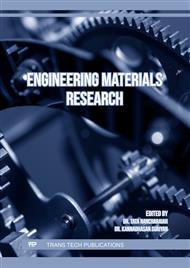[1]
Chang-Jiu Li, Xiao-Tao Luo, Shu-Wei Yao, Guang-Rong Li, Cheng-Xin Li & Guan-Jun Yang, The Bonding Formation during Thermal Spraying of Ceramic Coatings: A Review, J Ther Spray Tech, 31 (2022) 780–817
DOI: 10.1007/s11666-022-01379-z
Google Scholar
[2]
Yan Xin Dan,Yu Wang, Atsushi Nakamura, Hidetoshi Saitoh, Hua Li, Effect of microstructure on the thermal conductivity of thermal barrier coating deposited by chelate-flame spraying, Cer Int, 48 (2022) 12996-13005
DOI: 10.1016/j.ceramint.2022.01.173
Google Scholar
[3]
R. Spinelli, P. H. D Pasquali,.,A Bertotti,., D., Lerin, A. F Pitol, F. Patiño-Cambeiro, O Konrad, Development of Methodology for Determining the Physical Properties of Natural and Innovative Materials.Adv Materials Research, Trans Tech Publications, Ltd., 1156 (2019) 79–96. Crossref.
DOI: 10.4028/www.scientific.net/amr.1156.79
Google Scholar
[4]
Chakraborty, Surajit,. "An Explicit Thermal Resistance Model Regarding Self-Heating Effect of AlGaN/GaN High Electron Mobility Transistor." Mat Sci For Trans Tech Pub, Ltd., 1074 (2022) 125–131. Crossref.
DOI: 10.4028/p-ajv0ev
Google Scholar
[5]
Yingxia Liu, Yang Lu, K.N. Tu, Low temperature interfacial reaction in 3D IC nanoscale materials, Materials SciEng R: Reports, 151 (2022) 100701, ISSN 0927-796X.
DOI: 10.1016/j.mser.2022.100701
Google Scholar
[6]
Y.M. Yao, J. Cai, J. Gao, Q.F. Guan, P. Lyu, Y.Q. Hua, Y.X. Ye, W. Xue, Thermal cycling behavior and stress distribution in TGO layer of MCrAlYX-type coatings via high-current pulsed electron beam modification, App Sur Sci, 605 (2022) 154674, ISSN 0169-4332
DOI: 10.1016/j.apsusc.2022.154674
Google Scholar
[7]
Wen, ZHAO, Benguo KONG, Dejun. Friction–Wear Characteristics of High Velocity Oxygen Fuel Sprayed NiCrBSi Alloy Coating at Elevated Temperatures. Trans Ind Inst Metals, 71 (2018) 2565-2573.
DOI: 10.1007/s12666-018-1386-9
Google Scholar
[8]
Wang Song, Discussion on the Types Attribution and Comprehensive Utilization of High-Alumina Clay Ore. Adv Mat Res, Trans Tech Publications, Ltd., 807–809 (2013) 2209–2214. Crossref.
DOI: 10.4028/www.scientific.net/amr.807-809.2209
Google Scholar
[9]
Sangho Jeon, Xuanjiang Liu, Colby Azersky, Jie Ren, Shengbiao Zhang, Wen Chen, Robert W. Hyers, Kelly Costa, Matthias Kolbe, Douglas M. Matson, Particle size effects on dislocation density, microstructure, and phase transformation for high-entropy alloy powders, Mat, 18 (2021) 101161.
DOI: 10.1016/j.mtla.2021.101161
Google Scholar
[10]
Yuefang Peng, Ao Huang, Shenghao Li, Xinyu Chen, Huazhi Gu, Radical reaction-induced Turing pattern corrosion of alumina refractory ceramics with CaO–Al2O3–SiO2–MgO slags, JEurCer Soc; 43 (2023) 166-172.
DOI: 10.1016/j.jeurceramsoc.2022.09.044
Google Scholar
[11]
Rassim YOUNES, Mohand Amokrane BRADAI, Abdelhamid SADEDDINE, Youcef MOUADJI, Ali BILEK, Abderrahim BENABBAS, Effect of TiO2 and ZrO2 reinforcements on properties of Al2O3 coatings fabricated by thermal flame spraying, Trans Nonferrous Metals Soc China, 26 (2016) 1345-1352
DOI: 10.1016/S1003-6326(16)64237-1
Google Scholar
[12]
Li Yang, Xiaohong Shi, Xinfa Tian, Hanhui Wang, Lehua Qi, Microstructure and corrosion behavior of ZrO2 coated carbon fiber reinforced magnesium matrix composites sprayed with different powder characteristics, CerInt, 48 (2022) 30797-30806, ISSN 0272-8842.
DOI: 10.1016/j.ceramint.2022.07.033
Google Scholar
[13]
Liuyang Bai, Shanhong Wan, Gewen Yi, Huwei Sun,Exploring the influences of the counterpart materials on friction and wear behaviors of atmospheric plasma-sprayed YSZ coating, Ceramics International, 48, (2022), 29601-29613
DOI: 10.1016/j.ceramint.2022.06.214
Google Scholar
[14]
A Trodi, M. Benhamza, Heat Transfer Enhancement of Water Based Al2O3- Cu Hybrid Nanofluid Trough Square Cavity. Adv Mat Res, 1167 (2021) 87–100
DOI: 10.4028/www.scientific.net/amr.1167.87
Google Scholar
[15]
C.Y. Wang, M.H. Jiang, C.D. Wang, H.H. Liu, D. Zhao, Z.L. Chen, Modeling three-dimensional rough surface and simulation of temperature and flow field in laser transmission welding, J Adv Joi Proc, 1 (2020) 100021
DOI: 10.1016/j.jajp.2020.100021
Google Scholar
[16]
J. Choudhry , A.Almqvist, R. Larsson, Validation of a Multi-Scale Contact Temperature Model for Dry Sliding Rough Surfaces, Lubricants, 10 (2022) 41. https://doi.org/10.3390/ lubricants10030041
DOI: 10.3390/lubricants10030041
Google Scholar
[17]
Dongze Wang, Gregory De Boer, Anne Neville, Ali Ghanbarzadeh, A new numerical model for investigating the effect of surface roughness on the stick and slip of contacting surfaces with identical materials" Trib Int, 159(2021) 1657-1663
DOI: 10.1016/j.triboint.2021.106947
Google Scholar
[18]
Guangcan Luo, Dan Yang, Xuxiang Guo, Yinye Yang, Shengyun Luo, Jing Zhang, Mei Long, Li Xiang, Qinghon Li, Tengfei Wang, Wei Li, Quasi-ohmic contact formation assisted by the back contact with Cu2Te nanoparticles reduced graphene oxide composites for highly efficient CdTe solar cells, JAll Comp, 921(2022) 166100.
DOI: 10.1016/j.jallcom.2022.166100
Google Scholar
[19]
M. Dhamodaran, S. Jegadeesan and R. Praveen Kumar, Analysis and Calculation of the Fluid Flow and the Temperature Field by Finite Element Modeling, adv mat sci, 18 (2018) 59 - 64.
DOI: 10.1515/msr-2018-0009
Google Scholar
[20]
R. Younes, M. A.Bradai, A.Sadeddine, Y.Mouadji, A. Bilek, A.Benabbas, Met MatTrans B , 46 (2016) 2394-2403
DOI: 10.1007/s11663-015-0412-0
Google Scholar
[21]
R. Younes, M. A.Bradai, A. Sadeddine & Y. Mouadji, Microstructure and Tribological Performance of Thermally Sprayed Molybdenum Coating, Chem Afr, 5 (2022)269–278
DOI: 10.1007/s42250-021-00306-z
Google Scholar
[22]
Chuanwei Zhang, Dezhi Zheng, Young Woo Seo, Liqin Wang, Le Gu, The effect of a thermal contact sensor on the temperature distribution and heat flux at the disk surface, Trib Int, 131 (2019) 679-685, ISSN 0301-679X.
DOI: 10.1016/j.triboint.2018.11.016
Google Scholar
[23]
M. Shtern, M.Rogachev, Y. Shtern, D. Gromov, A. Kozlov, I. Karavaev, Thin-film contact systems for thermocouples operating in a wide temperature range, J All Comp, 852 (2021) 156889, ISSN 0925-8388.
DOI: 10.1016/j.jallcom.2020.156889
Google Scholar
[24]
L.Łatka, M. Michalak, M. Szala, M. Walczak, P.Sokołowski, A. Ambroziak, Influence of 13 wt% TiO2 content in alumina-titania powders on microstructure, sliding wear and cavitation erosion resistance of APS sprayed coatings, Surf Coat Tech, 410 (2021) 126979.
DOI: 10.1016/j.surfcoat.2021.126979
Google Scholar
[25]
Mengjun Chen, Qiang Li, Ping Zhang, Experimental investigation of high temperature thermal contact resistance of thin disk samples using infrared camera in vacuum condition, Int Jour Heat Mass Trans, 157 (2020) 119749, doi.org/.
DOI: 10.1016/j.ijheatmasstransfer.2020.119749
Google Scholar
[26]
Yi Liu, Rui Xu, Jianli Wang, Shanhong Wan, Liuyang Bai, Atomistic insight into flash temperature during friction,Int Communications in Heat and Mass Transfer , 138 (2022) 106317.
DOI: 10.1016/j.icheatmasstransfer.2022.106317
Google Scholar
[27]
G. Macêdo, L. Pelcastre, J. Hardell, High temperature friction and wear of post-machined additively manufactured tool steel during sliding against AlSi-coated boron steel, Wear, 98 (2023) 204753
DOI: 10.1016/j.wear.2023.204753
Google Scholar


